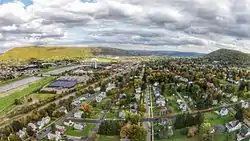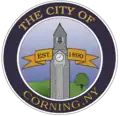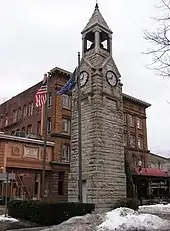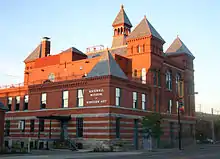Corning (city), New York
Corning is a city in Steuben County, New York, United States, on the Chemung River. The population was 11,183 at the 2010 census. It is named for Erastus Corning, an Albany financier and railroad executive who was an investor in the company that developed the community. The city is best known as the headquarters of Fortune 500 company Corning Incorporated, formerly Corning Glass Works, a manufacturer of glass and ceramic products for industrial, scientific and technical uses.
Corning | |
|---|---|
| City of Corning | |
 | |
 Seal | |
| Nickname(s): Crystal City | |
 Corning Location within the state of New York  Corning Corning (the United States) | |
| Coordinates: 42°8′53″N 77°3′25″W | |
| Country | United States |
| State | New York |
| County | Steuben |
| Government | |
| • Type | Council-Manager |
| • Mayor | William M. Boland, Jr (D) |
| • City Manager | Mark L. Ryckman |
| • City Council | Members' List [1]
|
| Area | |
| • Total | 3.26 sq mi (8.45 km2) |
| • Land | 3.08 sq mi (7.99 km2) |
| • Water | 0.18 sq mi (0.46 km2) |
| Elevation | 932 ft (284 m) |
| Population (2010) | |
| • Total | 11,183 |
| • Estimate (2019)[4] | 10,538 |
| • Density | 3,416.99/sq mi (1,319.41/km2) |
| Time zone | UTC−5 (Eastern (EST)) |
| • Summer (DST) | UTC−4 (EDT) |
| ZIP codes | 14830-14831 |
| Area code(s) | 607 |
| FIPS code | 36-18256 |
| GNIS feature ID | 0947476 [3] |
| Website | Corning, New York |
Overview

The city of Corning is situated at the western edge of the town of Corning and in the southeast part of Steuben County.
It is also home to the Corning Museum of Glass, which houses one of the world's most comprehensive collections of glass objects from antiquity to the present. The museum houses the Rakow Library,[5] one of the world's major glass research centers.
The city's other major cultural attraction is the Rockwell Museum. It contains an important collection of Western American painting and sculpture assembled over the past 40 years by Robert F. and Hertha Rockwell. The city has been cited several times by American Style magazine as one of the top twenty-five small city arts destinations in the U.S. – most recently in June 2010.[6] Many of the cultural events and historic landmarks in the city are in Corning's Gaffer District.
Corning Country Club annually hosted the Corning Classic, a stop on the Ladies Professional Golf Association tour, from 1979 to 2009. The city has commercial air service available at Elmira/Corning Regional Airport in the nearby town of Big Flats.
Corning is also home to the 2006 New York State Class A Football Champions.[7]
In 2003, Charles R. Mitchell and Kirk W. House produced Corning, a historic photo book in Arcadia Publishing's "Images of America" series. Photos were drawn from the archives of the Corning-Painted Post Historical Society.
In 2006, the city council approved public water fluoridation. In 2007, a petition was launched to ban this practice by local resident Kirk Huttleston which eventually became known as Proposition 1.[8] Proposition 1 passed the ban by a close vote of 1,287 to 1,222, according to unofficial results, leading to a full ban on public water fluoridation in 2008.[9]
In 2013, Rand McNally's list of best small towns in America named Corning the "Most Fun" town out of all the list's finalists.[10]
History
The first settlement in the town of Corning was made near the site of the future city in 1796. The community was set apart from the town as a village in 1848. Corning was incorporated as a city in 1890. As the glass industry developed, Corning became known as the "Crystal City" which was supported by companies such as Hawkes, Sinclair, and Hunt - which produced some of the finest American Brilliant Period cut glass between 1880 and 1915.
The Corning area's first real industry was lumber. The first settlers used the area's river systems to transport logs and finished lumber in fleets downstream to buyers. This gave rise to large mills which helped to develop the area. Rafting of lumber began to wane as timber was depleted. At one time the mills of the Corning area were reputed to be among the biggest in the world. After the lumber was depleted the great mills moved north to new forests.
East, across the Chemung River from Corning, lies Gibson, the site of a feeder canal for the Chemung Canal system. Some of Corning's early prosperity came from the feeder canal system exposure. Canal cargoes from Corning included soft coal, timber, tobacco, grain, and whiskey. From April 22 to December 11, 1850, the canal season that year, the newspaper reported that 1,116 boats left the port of Corning. Tolls for the year totaled $54,060.39. Among items shipped were 46,572,400 pounds of coal. The canal's best peacetime year was 1854 when 270,978 tons of freight were hauled. The Civil War brought an abnormal amount of business, with a peak of 307,151 tons hauled in one year.[11]
After the Civil War, an industrial boom occurred in the region. Ingersoll Rand opened during this period in Painted Post, just north of Corning.
Corning became a railroad town in the 1880s, many smaller railroad lines busily weaving webs of tracks connecting the major trunk line to smaller communities. In 1912, the Corning train wreck three miles east of Corning in Gibson left 39 dead.
The Jenning's Tavern, Corning Armory, Market Street Historic District, Southside Historic District, World War Memorial Library, and United States Post Office are listed on the National Register of Historic Places.[12]
The flood of 1972
The flood of 1972 was a major event for the area. On June 22, 1972, the storm that had been Hurricane Agnes struck the Southern Tier of New York. The storm combined with a storm system from Ohio to drop six to eight inches (203 mm) of rain in the Chemung River basin. This ultimately overwhelmed the flood control systems of the time, and the Chemung River broke through the dam system on Friday, June 23 at 4:00 a.m. By 9:00 a.m. the river crested and began to recede. In the Corning area, eighteen people were killed and untold millions of dollars of damage was incurred. An example of these expenses took place in the town of Bath, NY, where a local woman, Lila Marano cooked nearly 100 pizzas out of her home kitchen to accommodate students at the Haverling High School graduation reception at the local Maarit Assembly Hall. The river receded within hours, leaving mud which can still be found in basements of homes and businesses in Corning, and there is a section of the Corning Museum of Glass that indicates on the wall how high the flood waters rose.

Geography
Just upstream from Corning, the Cohocton River and the Tioga River merge to form the Chemung River which flows through downtown.[13] The river was an important source of power in the early history, and is part of the attractiveness of the region today.
The river is prone to floods, as rain water runs off quickly from the steep hillsides of the area. In 1972 the remnants of Hurricane Agnes dropped fifteen or more inches of rain in the area within a short time causing extensive flooding. Eighteen people were killed in the immediate Corning-Painted Post area. The entire downtown area was flooded, with severe damage. Flooding is now controlled by a system of dams upstream from Corning.
Interstate 86 (the Southern Tier Expressway), New York State Route 17, New York State Route 352, New York State Route 414, and New York State Route 415 are major highways connecting in Corning. County Road 40 leads into the city from the south and County Road 41 from the north. Interstate 99 and U.S. Route 15 proceeds southward from Painted Post, west of Corning.
According to the United States Census Bureau, the city has a total area of 3.3 square miles (8.5 km2), of which, 3.1 square miles (8.1 km2) of it is land and 0.2 square miles (0.4 km2) of it (5.18%) is water.
Demographics
As of the census[14] of 2010, there were 11,183 people in 5,114 households residing in the city. The population density was 3,626.1 people per square mile (1,346.0/km2). There were 5,519 housing units. The racial makeup of the city was 91.8% White, 3.2% Black or African American, 0.3% Native American, 1.8% Asian, Hispanic or Latino of any race were 2.4% of the population. 4.1% speak a language other than English at home.
In 2000, there were 4,996 households, out of which 26.2% had children under the age of 18 living with them, 37.6% were married couples living together, 12.3% had a female householder with no husband present, and 46.6% were non-families. 40.1% of all households were made up of individuals, and 15.5% had someone living alone who was 65 years of age or older. The average household size was 2.14 and the average family size was 2.89.
In the city, the population was spread out, with 23.3% under the age of 18, 8.6% from 18 to 24, 29.2% from 25 to 44, 21.1% from 45 to 64, and 17.8% who were 65 years of age or older. The median age was 38 years. For every 100 females, there were 87.5 males. For every 100 females age 18 and over, there were 83.5 males.
The median income for a household in the city was $32,780, and the median income for a family was $46,674. Males had a median income of $39,805 versus $27,489 for females. The per capita income for the city was $22,056. About 9.1% of families and 13.0% of the population were below the poverty line, including 18.4% of those under age 18 and 3.8% of those age 65 or over. In 2010, 20.4% were below the poverty line.
| Historical population | |||
|---|---|---|---|
| Census | Pop. | %± | |
| 1870 | 4,018 | — | |
| 1880 | 4,802 | 19.5% | |
| 1890 | 8,590 | 78.9% | |
| 1900 | 11,061 | 28.8% | |
| 1910 | 13,730 | 24.1% | |
| 1920 | 15,820 | 15.2% | |
| 1930 | 15,777 | −0.3% | |
| 1940 | 16,212 | 2.8% | |
| 1950 | 17,684 | 9.1% | |
| 1960 | 17,085 | −3.4% | |
| 1970 | 15,792 | −7.6% | |
| 1980 | 12,953 | −18.0% | |
| 1990 | 11,938 | −7.8% | |
| 2000 | 10,842 | −9.2% | |
| 2010 | 11,183 | 3.1% | |
| 2019 (est.) | 10,538 | [4] | −5.8% |
| Sources: 1790–1950,[15] 1960–1980,[16] 1990–2000[14] | |||
Politics
Most local officials are Republicans. The Corning area typically votes Republican, though some outsiders have deemed its constituents "moderate" Republicans. Amo Houghton, the area's long-serving U.S. congressman, was a moderate Republican. While the Town of Corning and surrounding areas are reliably Republican, The City of Corning leans Democratic, voting for both Barack Obama and Hillary Clinton in recent presidential elections.
Federal representatives
Corning is in New York's 23rd congressional district, which is currently represented by Republican Tom Reed.
State representatives
Corning is in New York's 53rd Senate District, represented by Tom O'Mara, a Republican. Corning is in the 136th Assembly District, represented by Phil Palmesano, also a Republican.
City mayors
Democrat Joseph Nasser served for many years as Corning's mayor, and the Nasser Civic Center, headquarters of city government, bears his name. In 2005 City Councilman Frank Coccho defeated incumbent Republican mayor Alan Lewis to become the first Democratic mayor since 1953. On November 6, 2007, Tom Reed, the head of the city's Republican Party, was elected to replace Coccho.[17][18] He completed his two-year term on December 31, 2009. Richard Negri was elected in November 2009 and took office January 1, 2010. Negri's second term expired December 31, 2013.
Democrat William Boland Jr. is the current mayor of Corning and has served in that capacity since January 2018. Prior to that, he served as deputy mayor for four years under Negri.[19]
Government
Since 1995, the city of Corning operates under the Council-Manager form of government, with the City Manager serving as the Chief Executive Officer. The first City Manager was Suzanne Kennedy who served until July 1997. In July 1997, Mark L. Ryckman was appointed as the city's second City Manager. The city council consists of eight members. One member is elected from each of the eight wards.
Education
The Corning-Painted Post (Consists of the City of Corning, and the Village of Painted Post) School District currently has six public elementary schools, one public middle school, and one public high school located in the greater Corning area.
In 2010 a referendum was passed that reconfigured the school district's secondary schools; both of the previous middle schools combined and moved into the former "West High School" building while both of the high schools combined at the former "East High School" campus. This reconfiguration / building project was finished by the beginning of the 2014–2015 school year.
In addition to the public and private school options, the Corning-Painted Post District also partners with a regional P-Tech school (known as "The Greater Southern Tier STEM Academy") and sends selected students to a grade 9-14 program on their campus.[20]
Public elementary schools include:
- Hugh W. Gregg
- Winfield Street
- William E. Severn
- Calvin U. Smith
- Erwin Valley
- Frederick Carder
- Lindley-Presho (closed)
Public middle schools include:
- Corning Free Academy (Before 2014–2015 school year)
- Northside Blodgett (Before 2014–2015 school year)
- Corning Painted Post Middle School (After 2013–current)
Public high schools include:
- East High School (Before 2014–2015 school year)
- West High School (Before 2014–2015 school year)
- High School Learning Center (HSLC)
- Corning Painted Post High School (After 2013–current)
Private schools in Corning include:
- The Alternative School for Math and Science (ASMS)
- All Saints Academy (a K–8 Catholic school)
- Corning Christian Academy (a P–12 evangelical Christian school)
Higher education in Corning includes:
Places of interest
Downtown
- Corning Museum of Glass: a not-for-profit museum dedicated to the art, history, science, and craft of glass.[22]
- The Gaffer District is the historic heart of Corning, featuring restored buildings, shopping, dining, and events through the year.[23]
- Market Street is Corning's historic main street, lined with restaurants and shopping.[23]
- The heart of Market Street is Centerway Square, a pedestrianized central square with a covered bandstand and public benches for public concerts and events. A restored historic clock tower serves as Centerway Square's focal point.[24]
Elsewhere in Corning
- Chimney Rocks – A group of tall rock formations that stood east of Corning. The rocks are no longer there but were so named because they were tall and narrow like chimneys.
- Bloody Run – An area near Gorton Creek, it was the site of a battle between forces of American generals John Sullivan and James Clinton and Native American villagers. This battle was part of a campaign directly ordered by George Washington to break the control of the Iroquois Indians in the area. It was called Bloody Run for the reports of bloody creek water coming from the battle scene.
- Horace D. Page Tunnel – A tunnel connecting the two divided areas of Denison Park, located on the city's South side. It was named after Page, who lost the naming rights to Elmira's Millers (formerly Page's) Pond in a 1912 horse racing bet at Tioga Downs, and was given naming rights to the tunnel as compensation.
- Heritage Village of the Southern Finger Lakes – Right in the heart of Corning, the Heritage Village is a Living History museum and the site of the Benjamin Patterson Inn, constructed in 1796 to draw settlers to the area. The site also includes a functioning blacksmith shop, one room school house, and an 1850s era log cabin.
Gallery
 Corning's Little Joe Tower
Corning's Little Joe Tower Corning
Corning Corning
Corning
Notable people
- Thomas S. Buechner (1926–2010), founding director of Corning Museum of Glass[25]
- Frederick Carder, glass artist[26]
- Joseph Costa, aviation pioneer
- Duane Eddy, Grammy Award-winning guitarist[27]
- Edd Hall, US television personality, announcer
- Katharine Houghton Hepburn (1878–1951), social activist, mother of Katharine Hepburn[28]
- Alanson B. Houghton, United States Congressman
- Amory Houghton, United States ambassador
- Amory "Amo" Houghton Jr., politician
- James R. Houghton, chairman of Corning Incorporated
- John N. Hungerford, United States Congressman
- Greg Keagle, MLB player[29]
- Harvey Littleton, glass artist[30]
- Eric Massa, United States Congressman
- Tom Reed, United States Congressman
- Margaret Higgins Sanger (1879 (born Margaret Louise Higgins)–1966), founder of American Birth Control League
- Samuel Sevian, chess prodigy, youngest Grandmaster US chess history[31]
- John Tillman, head lacrosse coach, University of Maryland[32]
- Charles C. B. Walker, United States Congressman
- Christie Wolf, champion female bodybuilder and professional wrestler best known for her stint in World Championship Wrestling[33]
Sister cities
Corning has three sister cities, as designated by Sister Cities International:
 Lviv, Ukraine
Lviv, Ukraine Kakegawa, Shizuoka, Japan (formerly Osuka which was annexed by Kakegawa)
Kakegawa, Shizuoka, Japan (formerly Osuka which was annexed by Kakegawa) San Giovanni Valdarno, Tuscany, Italy
San Giovanni Valdarno, Tuscany, Italy
See also
References
- http://cityofcorning.com/index.asp?Type=B_DIR&SEC={F493BB8D-3C93-4207-A7CC-CC4F7ABAD047}
- "2019 U.S. Gazetteer Files". United States Census Bureau. Retrieved July 27, 2020.
- U.S. Geological Survey Geographic Names Information System: Corning (city), New York
- "Population and Housing Unit Estimates". United States Census Bureau. May 24, 2020. Retrieved May 27, 2020.
- "Corning Museum of Glass". Archived from the original on 26 May 2008. Retrieved 21 September 2014.
- "American Style Magazine". Archived from the original on 2011-01-23. Retrieved 2011-01-28.
- "2006". New York State HIgh School Football State Playoff Results. Section 4 Football. Retrieved 10 July 2014.
- "Election Day will feature fluoride in Corning". Retrieved 21 September 2014.
- http://www.the-leader.com/article/20081105/News/311059889
- "Rand McNally Blog – News - Road Rally - Road Trips - Small Town Spotlight - America's Best Small Towns: The 2013 Winners". Archived from the original on 20 August 2014. Retrieved 21 September 2014.
- Corning, New York - The Crystal City - CorningNY.com Archived 2007-09-18 at the Wayback Machine
- "National Register Information System". National Register of Historic Places. National Park Service. March 13, 2009.
- Corning, NY, 7.5 Minute Topographic Quadrangle, USGS, 1953
- "U.S. Census website". United States Census Bureau. Retrieved 2008-01-31.
- United States Census Bureau. 1950 Census of Population; Volume 1: Characteristics of the Population; 1950 [Retrieved 2010-09-06]; p. 32-8 (64 in PDF file).
- 1980 Census of Population; Volume 1: Characteristics of the Population. United States Census Bureau; 1980 [Retrieved 2010-09-06]. p. 34-10.
- "Reed announces candidacy for Congress". The Leader - Corning, NY. Retrieved 21 September 2014.
- "Archived copy" (PDF). Archived from the original (PDF) on 2007-12-03. Retrieved 2007-11-17.CS1 maint: archived copy as title (link)
- https://www.usatoday.com/story/news/politics/elections/2019/04/01/mayor-bill-boland-seek-second-term-mayor-corning/3333685002/
- https://www.gstboces.org/stemacademy/
- "Archived copy". Archived from the original on 2015-01-18. Retrieved 2015-01-19.CS1 maint: archived copy as title (link)
- "About Us". Corning Museum of Glass. Retrieved 27 May 2019.
- "One Downtown, Many Personalities". Corning's Gaffer District. City of Corning. Retrieved 27 May 2019.
- "Centerway Square". Project for Public Spaces. Retrieved 27 May 2019.
- "Biography: Thomas S. Buechner". Corning Museum of Glass. Corning Museum of Glass. Retrieved 2 December 2014.
- "Biography: Frederick Carder". Corning Museum of Glass. Corning Museum of Glass. Retrieved 2 December 2014.
- "Duane Eddy Biography". Rock and Roll Hall of Fame. The Rock and Roll Hall of Fame and Museum, Inc. Retrieved 2 December 2014.
- "Katharine Houghton Hepburn". Connecticut Women's Hall of Fame. Connecticut Women's Hall of Fame. Retrieved 2 December 2014.
- "Staff Directory: Greg Keagle". RIT Athletics. Rochester Institute of Technology. Retrieved 2 December 2014.
- "Harvey K. Littleton and the American Studio Glass Movement". Corning Museum of Glass. Corning Museum of Glass. Retrieved 2 December 2014.
- "FIDE Chess Profile: Samuel Sevian". World Chess Federation. World Chess Federation. Retrieved 2 December 2014.
- "John Tillman". Maryland Terrapins Athletics. University of Maryland. Retrieved 2 December 2014.
- "Christie Wolf at the Almanac of Women's Bodybuilding".
- Dimitroff, Thomas P.; Janes, Lois S. (1990). History of the Corning Painted Post Area, 200 years in Painted Post Country.
External links
| Wikimedia Commons has media related to Corning, New York. |
| Wikisource has the text of The New Student's Reference Work article "Corning, N. Y.". |
- Official website
- Chamber of Commerce website
- The short film "Welcome to Corning, New York: Tropical Storm Agnes Flood (1972)" is available for free download at the Internet Archive


